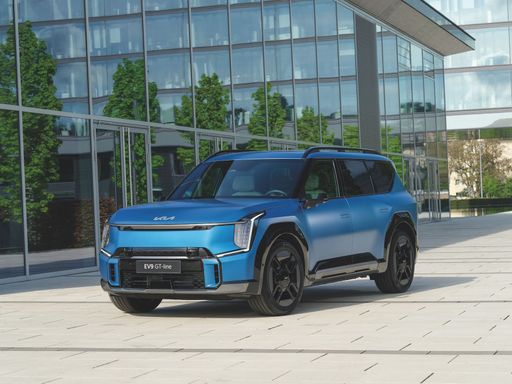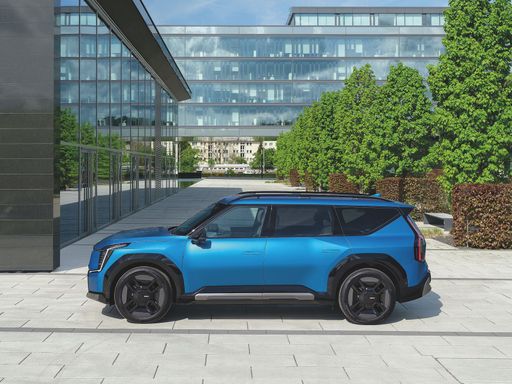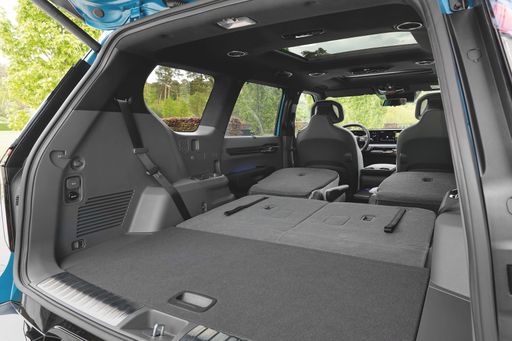Kia EV9 vs Hyundai IONIQ 9 – Performance, range & efficiency compared
Two cars, one duel: Kia EV9 meets Hyundai IONIQ 9.
Which one wins in performance, efficiency and value for money? Find out now!
Here’s where it gets real: The technical differences in detail
Costs and Efficiency: Price and efficiency are often the first things buyers look at. Here it becomes clear which model has the long-term edge – whether at the pump, the plug, or in purchase price.
Kia EV9 has a slightly advantage in terms of price – it starts at 53100 £, while the Hyundai IONIQ 9 costs 58700 £. That’s a price difference of around 5580 £.
In terms of energy consumption, the advantage goes to the Kia EV9: with 19.50 kWh per 100 km, it’s minimal more efficient than the Hyundai IONIQ 9 with 19.90 kWh. That’s a difference of about 0.40 kWh.
As for range, the Hyundai IONIQ 9 performs slight better – achieving up to 620 km, about 57 km more than the Kia EV9.
Engine and Performance: Power, torque and acceleration say a lot about how a car feels on the road. This is where you see which model delivers more driving dynamics.
When it comes to engine power, the Kia EV9 has a slightly edge – offering 508 HP compared to 428 HP. That’s roughly 80 HP more horsepower.
In acceleration from 0 to 100 km/h, the Kia EV9 is slightly quicker – completing the sprint in 4.60 s, while the Hyundai IONIQ 9 takes 5.20 s. That’s about 0.60 s faster.
In terms of top speed, the Kia EV9 performs slight better – reaching 220 km/h, while the Hyundai IONIQ 9 tops out at 200 km/h. The difference is around 20 km/h.
There’s also a difference in torque: the Kia EV9 pulls hardly perceptible stronger with 740 Nm compared to 700 Nm. That’s about 40 Nm difference.
Space and Everyday Use: Cabin size, boot volume and payload all play a role in everyday practicality. Here, comfort and flexibility make the difference.
Both vehicles offer seating for 7 people.
In curb weight, the Kia EV9 is barely noticeable lighter – 2392 kg compared to 2594 kg. The difference is around 202 kg.
In terms of boot space, the Hyundai IONIQ 9 offers slight more room – 338 L compared to 333 L. That’s a difference of about 5 L.
In maximum load capacity, the Hyundai IONIQ 9 performs hardly perceptible better – up to 2419 L, which is about 26 L more than the Kia EV9.
When it comes to payload, Hyundai IONIQ 9 slight takes the win – 643 kg compared to 615 kg. That’s a difference of about 28 kg.
All in all, the Kia EV9 shows itself to be leads convincingly overall and secures the title of DriveDuel Champion.
It impresses with the more balanced overall package and proves to be the more versatile companion for everyday use.
Kia EV9
The Kia EV9 represents a bold step forward in the automotive world with its distinctive design and futuristic appeal. This all-electric SUV promises to provide a spacious and comfortable cabin experience, making it ideal for families and long journeys. With its emphasis on sustainability and advanced technology, the EV9 aims to redefine the standards for electric vehicles in its category.
details @ press.kia.com
@ press.kia.com
 @ press.kia.com
@ press.kia.com
 @ press.kia.com
@ press.kia.com
 @ press.kia.com
@ press.kia.com
 @ press.kia.com
@ press.kia.com
Hyundai IONIQ 9
The Hyundai IONIQ 9 is a bold step forward in the automotive world, combining cutting-edge electric technology with a sleek and modern design. This model stands out with its spacious interior and advanced features, ensuring both comfort and convenience for drivers and passengers alike. As Hyundai pushes the envelope in eco-friendly innovation, the IONIQ 9 represents the future of sustainable driving with its impressive range and performance capabilities.
details

|
|
|
|
|
Costs and Consumption |
|
|---|---|
|
Price
53100 - 78000 £
|
Price
58700 - 74400 £
|
|
Consumption L/100km
-
|
Consumption L/100km
-
|
|
Consumption kWh/100km
19.5 - 22.8 kWh
|
Consumption kWh/100km
19.9 - 20.6 kWh
|
|
Electric Range
443 - 563 km
|
Electric Range
600 - 620 km
|
|
Battery Capacity
76.1 - 99.8 kWh
|
Battery Capacity
110 kWh
|
|
co2
0 g/km
|
co2
0 g/km
|
|
Fuel tank capacity
-
|
Fuel tank capacity
-
|
Dimensions and Body |
|
|---|---|
|
Body Type
SUV
|
Body Type
SUV
|
|
Seats
6 - 7
|
Seats
7
|
|
Doors
5
|
Doors
5
|
|
Curb weight
2392 - 2664 kg
|
Curb weight
2594 - 2689 kg
|
|
Trunk capacity
333 L
|
Trunk capacity
338 L
|
|
Length
5010 - 5015 mm
|
Length
5060 mm
|
|
Width
1980 mm
|
Width
1980 mm
|
|
Height
1755 - 1780 mm
|
Height
1790 mm
|
|
Max trunk capacity
2318 - 2393 L
|
Max trunk capacity
2419 L
|
|
Payload
542 - 615 kg
|
Payload
586 - 643 kg
|
Engine and Performance |
|
|---|---|
|
Engine Type
Electric
|
Engine Type
Electric
|
|
Transmission
Automatic
|
Transmission
Automatic
|
|
Transmission Detail
Reduction Gearbox
|
Transmission Detail
Reduction Gearbox
|
|
Drive Type
All-Wheel Drive, Rear-Wheel Drive
|
Drive Type
Rear-Wheel Drive, All-Wheel Drive
|
|
Power HP
204 - 508 HP
|
Power HP
218 - 428 HP
|
|
Acceleration 0-100km/h
4.6 - 9.4 s
|
Acceleration 0-100km/h
5.2 - 9.4 s
|
|
Max Speed
185 - 220 km/h
|
Max Speed
190 - 200 km/h
|
|
Torque
350 - 740 Nm
|
Torque
350 - 700 Nm
|
|
Number of Cylinders
-
|
Number of Cylinders
-
|
|
Power kW
150 - 374 kW
|
Power kW
160 - 315 kW
|
|
Engine capacity
-
|
Engine capacity
-
|
General |
|
|---|---|
|
Model Year
2023 - 2025
|
Model Year
2025
|
|
CO2 Efficiency Class
A
|
CO2 Efficiency Class
A
|
|
Brand
Kia
|
Brand
Hyundai
|
Is the Kia EV9 offered with different drivetrains?
The Kia EV9 is offered with All-Wheel Drive or Rear-Wheel Drive.
The prices and data displayed are estimates based on German list prices and may vary by country. This information is not legally binding.
